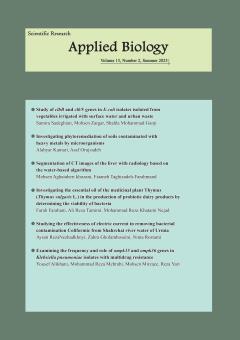Segmentation of CT images of the liver with radiology based on the water-based algorithm
Subject Areas : biologyMohsen AghataheriKhozani 1 , Fataneh Taghizadeh-Farahmand 2
1 - Master's Student, Department of Radiology, Faculty of Basic Sciences, Qom Branch, Islamic Azad University, Qom, Iran.
2 - Associate Professor, Department of Physics, Faculty of Basic Sciences, Qom Branch, Islamic Azad University, Qom, Iran
Keywords: Radiology, CT images, Image processing, Liver, Watershed algorithm.,
Abstract :
Purpose: The purpose of the present study is to segment the CT images of the liver with radiology based on the watershed algorithm. Materials and methods: In this study, a semi-automated method for dividing liver tumors using CT scan images has been presented. First, the tumor and liver tissue is determined by the user with point selection. Then, with the help of Abpakhshan method, the three-dimensional morphology of the primary points in the tumor and liver are determined. Then, estimation of tumor and liver tissue labels is done with the method of propagation of dependent constraints. By taking the distance between the obtained labels, the tumor boundary is obtained, and finally, the final boundaries of the tumor are determined by using the edge detector. Findings: Changes in the number of initial points have little effect on the output results. In the CAP method, considering that the data estimation is done using the sampled points and estimates around these points, with any number of initial samples, the CAP method is able to produce the final results, which shows the high power of the CAP method in It is an estimate of the data. Conclusion: The use of the watershed algorithm improves the segmentation of CT images of the liver with radiology.
1. Altini N, Prencipe B, Cascarano GD, Brunetti A, Brunetti G, Triggiani V & et al. Liver, kidney and spleen segmentation from CT scans and MRI with deep learning: A survey. Neurocomputing. 2022; 490: 30-53.
2. Valindria VV, Pawlowski N, Rajchl M, Lavdas I, Aboagye EO, Rockall AG & et al. Multi-modal learning from unpaired images: Application to multi-organ segmentation in CT and MRI. In: 2018 IEEE winter conference on applications of computer vision (WACV) (pp. 547-556). IEEE.
3. Wang K, Mamidipalli A, Retson T, Bahrami N, Hasenstab K, Blansit, K & et al. Automated CT and MRI liver segmentation and biometry using a generalized convolutional neural network. Radiology: Artificial Intelligence. 2019; 1(2).
4. Raju A, Cheng CT, Huo Y, Cai J, Huang J, Xiao J. & et al. Co-heterogeneous and adaptive segmentation from multi-source and multi-phase CT imaging data: a study on pathological liver and lesion segmentation. In: European Conference on Computer Vision (pp. 448-465). Springer, Cham, 2020.
5. Vorontsov E, Cerny M, Régnier P, Di Jorio L, Pal CJ, Lapointe R & et al. Deep learning for automated segmentation of liver lesions at CT in patients with colorectal cancer liver metastases. Radiology: Artificial Intelligence. 2019; 1(2).
6. Lebre MA, Vacavant A, Grand-Brochier M, Rositi H, Strand R, Rosier H & et al. (2019). A robust multi-variability model-based liver segmentation algorithm for CT-scan and MRI modalities. Computerized Medical Imaging and Graphics. 2019; 76.
7. Zhou LQ, Wang JY, Yu SY, Wu GG, Wei Q, Deng, YB & et al. Artificial intelligence in medical imaging of the liver. World journal of gastroenterology. 2019; 25(6): 672.
8. Montagnon E, Cerny M, Cadrin-Chênevert A, Hamilton V, Derennes T, Ilinca A & et al. Deep learning workflow in radiology: a primer. Insights into imaging. 2020; 11(1): 1-15.
9. Qayyum A, Lalande A & Meriaudeau F. Automatic segmentation of tumors and affected organs in the abdomen using a 3D hybrid model for computed tomography imaging. Computers in Biology and Medicine. 2020; 127.
10. Xu Y, Cai M, Lin L, Zhang Y, Hu H, Peng Z & et al. PA‐ResSeg: A phase attention residual network for liver tumor segmentation from multiphase CT images. Medical Physics. 2021; 48(7): 3752-3766.
11. Homayounieh F, Singh R, Nitiwarangkul C, Lades F, Schmidt B, Sedlmair M & et al. Semiautomatic segmentation and radiomics for dual-energy CT: a pilot study to differentiate benign and malignant hepatic lesions. American Journal of Roentgenology. 2020; 215(2): 398-405.
12. Jirapatnakul A, Reeves AP, Lewis S, Chen X, Ma T, Yip R & et al. Automated measurement of liver attenuation to identify moderate-to-severe hepatic steatosis from chest CT scans. European journal of radiology. 2020; 122.
13. Chlebus G, Schenk A, Moltz JH, van Ginneken B, Hahn HK, & Meine H. Automatic liver tumor segmentation in CT with fully convolutional neural networks and object-based postprocessing. Scientific reports. 2018; 8(1): 1-7.
14. Kushnure DT, & Talbar SN. MS-UNet: A multi-scale UNet with feature recalibration approach for automatic liver and tumor segmentation in CT images. Computerized Medical Imaging and Graphics. 2021; 89.
15. Yamashita R, Nishio M, Do RKG & Togashi K (2018). Convolutional neural networks: an overview and application in radiology. Insights into imaging. 9(4): 611-629.
16. Choi KJ, Jang JK, Lee SS, Sung YS, Shim WH, Kim HS & et al. Development and validation of a deep learning system for staging liver fibrosis by using contrast agent–enhanced CT images in the liver. Radiology. 2018; 289(3): 688-697.
17. Wu J, Furuzuki M, Li G, Kamiya T, Mabu S, Tanabe M & et al. Segmentation of liver tumors in multiphase computed tomography images using hybrid method. Computers & Electrical Engineering. 2022; 97.
18. Naeem S, Ali A, Qadri S, Khan Mashwani W, Tairan N, Shah H & et al. Machine-learning based hybrid-feature analysis for liver cancer classification using fused (MR and CT) images. Applied Sciences. 2020; 10(9): 3134.
19. Nanda N, Kakkar P & Nagpal S. Computer-aided segmentation of liver lesions in CT scans using cascaded convolution neural networks and genetically optimized classifier. Arabian Journal for Science and Engineering. 2019; 44(4): 4049-4062.
20. Freman S, Haak D & Wenderoth MP. Increased Course Structure Improves Performance in Introductory Biology. CBE Life Sci Educ. 2011; 10(2): 175-186.


